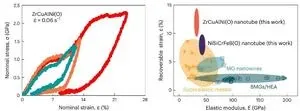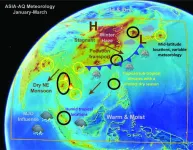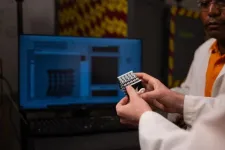(Press-News.org) Oxidation can degrade the properties and functionality of metals. However, a research team co-led by scientists from City University of Hong Kong (CityU) recently found that severely oxidized metallic glass nanotubes can attain an ultrahigh recoverable elastic strain, outperforming most conventional super-elastic metals. They also discovered the physical mechanisms underpinning this super-elasticity. Their discovery implies that oxidation in low-dimension metallic glass can result in unique properties for applications in sensors, medical devices and other nanodevices.
In recent years, the functional and mechanical properties of low-dimensional metals, including nanoparticles, nanotubes and nanosheets, have garnered attention for their potential applications in small-scale devices, such as sensors, nano-robots and metamaterials. However, most metals are electrochemically active and susceptible to oxidation in ambient environments, which often degrades their properties and functionalities.
“Metallic nanomaterials have a high surface-to-volume ratio, which can be up to 108m-1. So in principle, they are expected to be particularly prone to oxidation,” said Professor Yang Yong, in the Department of Mechanical Engineering at CityU, who led the research team together with his collaborators. “To use low-dimensional metals to develop next-generation devices and metamaterial, we must thoroughly understand the adverse effects of oxidation on the properties of these nanometals and then find a way to overcome them.”
Therefore, Professor Yang and his team investigated oxidation in nanometals, and in sharp contrast to their expectation, they found that severely oxidized metallic glass nanotubes and nanosheets can attain an ultrahigh recoverable elastic strain of up to about 14% at room temperature, which outperforms bulk metallic glasses, metallic glass nanowires, and many other super-elastic metals.
They made metallic glass nanotubes with an average wall thickness of just 20nm, and fabricated nanosheets from different substrates, such as sodium chloride, polyvinyl alcohol and conventional photoresist substrates, with different levels of oxygen concentration.
They then conducted 3D atom probe tomography (APT) and electron energy loss spectroscopy measurements. In both the results, oxides were dispersed within the metallic glass nanotubes and nanosheets, unlike conventional bulk metals, in which a solid oxide layer forms on the surface. As the oxygen concentration in the samples increased owing to metal–substrate reactions, connected and percolating oxide networks were formed inside the nanotubes and nanosheets.
In-situ microcompression measurements also revealed that the severely oxidized metallic glass nanotubes and nanosheets exhibited a recoverable strain of 10–20%, which was several times more than that of most conventional superelastic metals, such as shape memory alloys and gum metals. The nanotubes also had an ultra-low elastic modulus of about 20–30 GPa.
To understand the mechanism behind this, the team conducted atomistic simulations, which indicated that the superelasticity originates from severe oxidation in the nanotubes and can be attributed to the formation of a damage-tolerant percolation network of nano-oxides in the amorphous structure. These oxide networks not only restrict atomic-scale plastic events during loading, but also lead to the recovery of elastic rigidity on unloading in metallic glass nanotubes.
“Our research introduces a nano-oxide engineering approach for low-dimensional metallic glasses. The morphology of nano-oxides within metallic-glass nanotubes and nanosheets can be manipulated by adjusting the oxide concentration, ranging from isolated dispersions to a connected network,” said Professor Yang.
“With this approach, we can develop a class of heterogeneous nanostructured ceramic-metal composites by blending metals with oxides at the nanoscale. Such composites have great potential for various future commercial applications and nanodevices working in harsh environments, such as sensors, medical devices, micro- and nano-robots, springs and actuators,” he added.
The findings were published in Nature Materials under the title “Oxidation-induced superelasticity in metallic glass nanotubes”.
The first authors are Dr Li Fucheng and Mr Zhang Zhibo, who are former and current PhD students, respectively, of Prof Yang, and Dr Liu Huanrong from the Beijing Computational Science Research Center (CSRC). The corresponding authors are Professor Yang, Professor Liu Yanhui, from the Institute of Physics of the Chinese Academy of Sciences, and Professor Guan Pengfei, from the CSRC. The research is supported by the General Research Fund of the Research Grants Council of Hong Kong and the National Natural Science Foundation of China.
https://www.cityu.edu.hk/research/stories/2024/02/02/unveiling-oxidation-induced-super-elasticity-metallic-glass-nanotubes
END
Unveiling Oxidation-induced Super-elasticity in Metallic Glass Nanotubes
2024-02-02
ELSE PRESS RELEASES FROM THIS DATE:
Ambitious workers park the office politics when employer is struggling, study suggests
2024-02-02
One of the study authors, Professor Hans Frankort, Professor of Strategy at Bayes Business School, City, University of London, said: “Sports – particularly motorsports – can be a good proxy for several other industries as they are extremely competitive: if you don’t perform and progress you may be out. Workers in sectors such as consultancy and financial services face similar pressures.”
The peer reviewed paper, which has been published on the website of the Academy of Management Journal, found that riders systematically adjusted their internal ...
Speech Accessibility Project begins recruiting people who have had a stroke
2024-02-02
The Speech Accessibility Project has begun recruiting U.S. and Puerto Rican adults who have had a stroke.
Those interested can sign up online.
Funded by Big Tech companies Amazon, Apple, Google, Meta, and Microsoft, the University of Illinois Urbana-Champaign aims to train voice recognition technologies to understand people with diverse speech patterns and disabilities. The project is also recruiting adults with Parkinson’s disease, Down syndrome, cerebral palsy, and amyotrophic lateral sclerosis.
“A stroke can cause big changes, including changes to your ability to speak,” said Mark Hasegawa-Johnson, the project’s ...
Urgent need to address health equity at intersection of American Heart Month and Black History Month 2024
2024-02-02
DALLAS, Feb. 2, 2024 — Black Americans have the highest incidence of cardiac arrest outside of the hospital and are significantly less likely to survive.[1] Cardiac arrest in Black neighborhoods is associated with alarmingly low treatment and survival rates and recent studies have shown lower rates of both bystander CPR and bystander AED use in these neighborhoods. Recognizing the unique intersection of American Heart Month and Black History Month, the American Heart Association, celebrating 100 years of service saving lives, marks the occasion by honoring ...
NRG Oncology selects Health Equity Fellows for 2024
2024-02-02
PHILADELPHIA, PA – NRG Oncology (NRG), a National Cancer Institute (NCI) National Clinical Trials Network (NCTN) group, recently announced that they have named two health equity fellows as a part of the organization’s Health Equity Fellowship Program. Fellowship awardees include Dr. Onyinye Balogun and Dr. Stephanie Rieder.
NRG’s Health Equity Fellowship Program was established by Joan Walker, MD, of the University of Oklahoma and an NRG NCI Community Oncology Research Program (NCORP) Principal Investigator, to train selected ...
Neptune-like exoplanets can be cloudy or clear — new findings suggest the reason why
2024-02-02
LAWRENCE — The study of “exoplanets,” the sci-fi-sounding name for all planets in the cosmos beyond our own solar system, is a pretty new field. Mainly, exoplanet researchers like those in the ExoLab at the University of Kansas use data from space-borne telescopes such as the Hubble Space Telescope and Webb Space Telescope. Whenever news headlines offer findings of “Earth-like” planets or planets with the potential to support humanity, they’re talking about exoplanets within our own Milky Way.
Jonathan Brande, a doctoral candidate in the ExoLab at the University of Kansas, has just published findings in the open-access ...
nTIDE January 2024 Jobs Report: Despite minor shifts, employment for people with disabilities remains near historic highs
2024-02-02
East Hanover, NJ – February 2, 2024 – Labor market indicators showed slight declines over the last two months for both people with and without disabilities, according to today’s National Trends in Disability Employment – semi-monthly update (nTIDE), issued by Kessler Foundation and the University of New Hampshire’s Institute on Disability (UNH-IOD). These declines may reflect the end of seasonal employment and the impact of the Federal Reserve’s anti-inflationary measures aimed at minimizing the risk of recession. ...
NRL joins Airborne and Satellite Investigation of Asian Air Quality (ASIA-AQ)
2024-02-02
WASHINGTON – U.S. Naval Research Laboratory (NRL) meteorologists, in partnership with NASA, will join a team of international scientists to participate in the Airborne and Satellite Investigation of Asian Air Quality (ASIA-AQ) experiment beginning on February 2.
NRL’s collaborators, David Peterson, Ph.D., meteorologist, Theodore McHardy, Ph.D., American Society for Engineering Education postdoctoral researcher, Nicholas Gapp, Science Applications International Corporation ...
New drug could prevent diabetic eye and kidney disease in people with diabetes
2024-02-02
New research has shown a new type of inhibitor drug could prevent microvascular diabetic complications, such as diabetic eye and kidney disease. The University of Bristol-led research is published in Cardiovascular Diabetology.
Diabetes, a disease which results in uncontrolled blood glucose levels, is estimated to affect one in 11 adults worldwide. Even when managed, this common disease can result in life-altering complications, impacting the small blood vessels of the body, known as the microvasculature.
While treatments ...
UT research breaking records, growing impact in Tennessee and beyond
2024-02-02
The University of Tennessee, Knoxville, continued to expand its impact and research footprint last year, breaking university records for both research expenditures and sponsored project awards for the second straight year.
Since 2019, UT has more than doubled its sponsored project awards, reaching a record $428 million in the fiscal year that ended in June 2023. The university also reported $339 million in research expenditures in fiscal year 2023, an increase of nearly $15 million over fiscal year 2022 and the highest amount in UT history. Research expenditures include internal and external funds that support UT research ...
Rare 3D fossils show that some early trees had forms unlike any you’ve ever seen
2024-02-02
In the fossil record, trees typically are preserved with only their trunks. They don’t usually include any leaves to show what their canopies and overall forms may have looked like. But now, researchers reporting in the journal Current Biology on February 2 describe fossilized trees from New Brunswick, Canada with a surprising and unique three-dimensional crown shape.
“The way in which this tree produced hugely long leaves around its spindly trunk, and the sheer number over a short length of trunk, is startling,” says Robert Gastaldo of Colby College in Waterville, Maine.
The forms taken by these ...







